ikfoundation.org
Promoting Natural & Cultural History



ESSAYS |
MAIL-ORDER OR TRAVELS TO PURCHASE CLOTHING
– Advertisements from 1860 to 1914
In the local Whitby Gazette, advertisements from places other than Whitby first appeared about 1870, but were very rare before 1900, though increased considerably after that date. These businesses would either be within a day’s journey of Whitby, or firms that hoped to sell their products by mail-order from the larger towns of England. This essay will give detailed examples of competition from larger towns for the local drapery shops in a small coastal town like Whitby. Steamers by sea or journeys via timetabled railways or coaches, gave greater possibilities for shopping and being up-to-date with the newest fashions. Likewise, customer orders via mail could be transported more easily due to the expanding rail network during this period.
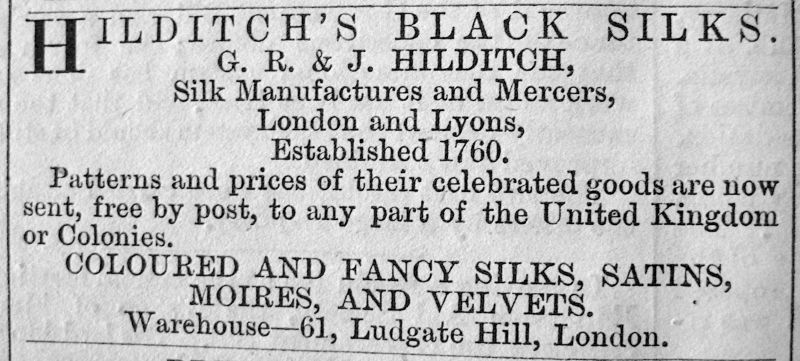 Whitby Gazette, May-June in 1870, Hilditch Silk Manufactures and Mercers of London. (Collection: Whitby Museum, Library & Archive, Whitby). Photo: Viveka Hansen, The IK Foundation, London.
Whitby Gazette, May-June in 1870, Hilditch Silk Manufactures and Mercers of London. (Collection: Whitby Museum, Library & Archive, Whitby). Photo: Viveka Hansen, The IK Foundation, London.The earliest to be found was in the spring of 1870. G.R & J. Hilditch Silk Manufacturers and Mercers of London had, as one can see in the illustration above, a history going back over a hundred years – in London as well as Lyon – and sent their samples and price-lists ‘free by post, to any part of the United Kingdom or Colonies’. What they were particularly anxious to advertise were their exclusive black cloths and: ‘Silks, Satins, Moires and Velvets’.
The second out-of-town advertisement in 1870 came from a business in Hinderwell, some eight miles from Whitby, where I. Jefferson, Draper and Tailor, &c. wished to make known that he had gone into partnership with another proficient tailor: ‘Mr. Hooper has recently returned from London, where he has perfected himself in the Cutting Department at a first-class Establishment.’ The railway line out of Whitby along the coast to the north was not opened until 1883, so the best way for customers to reach Hinderwell in 1870 was by the Coach, also known as the ‘Omnibus’ from Whitby; according to announcements in the Whitby Gazette, this went three times a week (see image below). However, it is not possible to be sure of the range of distribution of the Gazette, which may have been taken each week to Hinderwell by coach to be sold there too, or the inhabitants of Hinderwell could equally well buy the paper on their visits to Whitby. In other words it is possible that the draper attracted not merely the population of Whitby with his advertisement, but perhaps just as much or even more those living in his own village.
Jefferson of Hinderwell expanded his business after the opening of the railway with a shop in nearby Staithes, advertising from 18 April 1889 as Skelton and Jefferson, who offered both ‘Tailoring and Ready-Mades’ within ‘Millinery and Drapery’. The business was still in existence around 1910, and advertising regularly, though once more restricted to premises only in Hinderwell. They now laid emphasis on ‘Special Tailor-Made to Your Measure’ and ‘These are the Smartest and Best Value in the Trade’; in other words, their motto was a good fit at a fair price.
-900x639.jpg) Whitby Gazette Dec 28, 1867, The ‘Whitby and Saltburn Omnibus’ – passing by Hinderwell. At this time people did not travel so much to transport goods over land (though naturally this was possible), but the omnibus was the most important method of all land transport before the railway reached several parts of the district. (Collection: Whitby Museum, Library & Archive). Photo: Viveka Hansen, The IK Foundation, London.
Whitby Gazette Dec 28, 1867, The ‘Whitby and Saltburn Omnibus’ – passing by Hinderwell. At this time people did not travel so much to transport goods over land (though naturally this was possible), but the omnibus was the most important method of all land transport before the railway reached several parts of the district. (Collection: Whitby Museum, Library & Archive). Photo: Viveka Hansen, The IK Foundation, London.Christmas 1875 featured an advertisement from Marshall and Snelgrove of St Nicholas Street Scarborough (a branch of Marshall and Snelgrove’s main store in London), which had a sale of ‘The remaining Stock of Made-Up Silk Dresses, Cloaks, Drapery, Costumes, Children’s Dresses, Millinery, and all Fancy Articles...’ Whether customers in Whitby were able to make their way to Scarborough in winter must have depended entirely on the weather. The two towns were not connected by rail until 1885, so the two possible alternatives were the public highway, which could be very difficult at that time of year running an extremely precipitous and winding course between Whitby and Scarborough, and the steamboat, which must have been the preferred route since it linked the two towns with regular sailings even in winter. This form of transport was also quicker, safer and more comfortable than the road. The Scarborough was the largest of the ferries operating between 1866 and 1914, with room for up to 300 passengers.
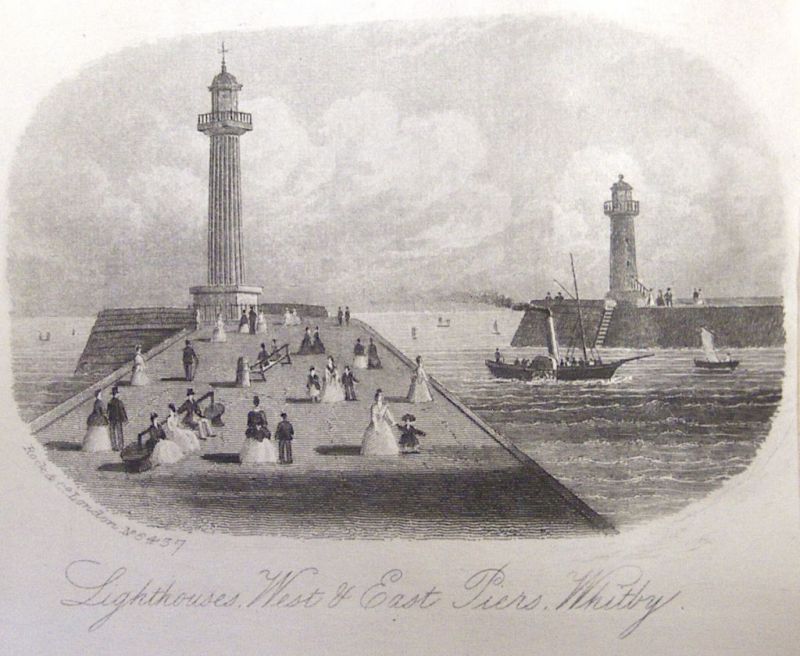 ‘Lighthouses West & East Piers Whitby’ c.1860s. At this time steamships coexisted with sail in Whitby harbour – sailing to Scarborough among other places – as can be seen in this print. (Courtesy of: Whitby Museum, Library & Archive, Local Prints and Papers, 942.747).
‘Lighthouses West & East Piers Whitby’ c.1860s. At this time steamships coexisted with sail in Whitby harbour – sailing to Scarborough among other places – as can be seen in this print. (Courtesy of: Whitby Museum, Library & Archive, Local Prints and Papers, 942.747).Summer 1898 saw an advertisement from another business outside Whitby that stressed ‘Lowest Prices for quality’; this was Simpsons & Sons, ‘The Tailors and Clothiers’ of ‘39 & 40 Parliament Street and Pavement York’, who claimed to hold the ‘Largest Stock in Yorkshire.’ The quickest way for customers from Whitby to visit this large stock of textiles would have been to take the train to Scarborough, which had been in existence almost fifteen years by this time, and change there for York, a line open since 1845. If travellers preferred to stay in Scarborough, there was a large choice of shops there, too, some of which, in any case, advertised in the Whitby Gazette from 1899-1909. These advertisers included around the turn of the century J. Tonks & Sons of 104 & 105 Westborough, Scarborough, who in February 1899 aimed to sell ‘Carpets, Linoleums, Muslins, and Art Blinds’, and were at the same time also active upholsterers. If customers preferred not to take the train, orders could be sent by telegram to “Tonks Scarboro”, or they could dial number 31 on that still recent invention, the telephone. Another shop nearby was Hopper & Mason, of 100 & 101 Westborough, Scarborough – which in August 1903 offered ready-made skirts in thick quality wool that would suit the modern Edwardian woman for ‘21s.’ An illustration was appended and the advertisers described ‘Our Specialite, A Superior Skirt in Shape and Finish made of Scarborough’s Fearnoucht Serge, Guaranteed not to shrink or spot, a most desirable garment for Golfing, Walking or Seaside Wear, &c’.
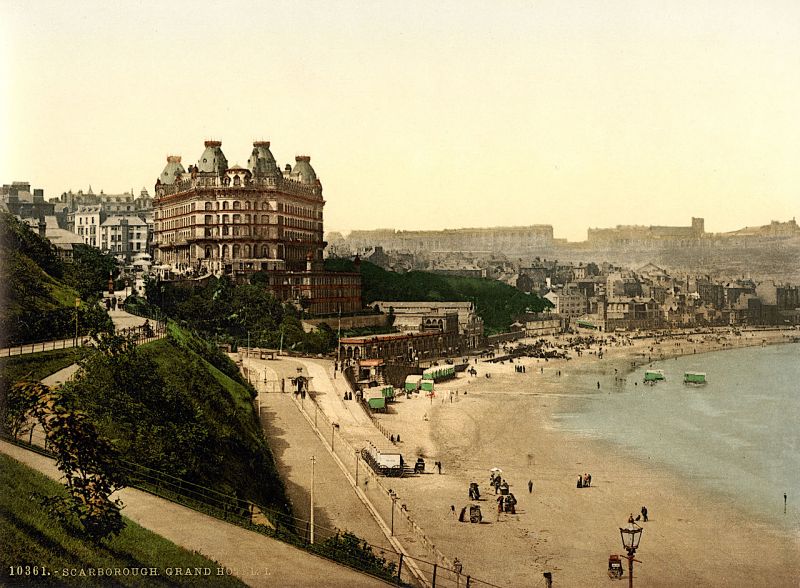 Scarborough was not only popular by Whitby residents and tourists for larger choice of fashionable shopping, but had also been one of the most popular seaside resorts along the east coast for a long time. ‘Grand Hotel, Scarborough, Yorkshire, England, 1890s’. (Courtesy of: Wikimedia Commons).
Scarborough was not only popular by Whitby residents and tourists for larger choice of fashionable shopping, but had also been one of the most popular seaside resorts along the east coast for a long time. ‘Grand Hotel, Scarborough, Yorkshire, England, 1890s’. (Courtesy of: Wikimedia Commons).Another business from the same town that advertised frequently during this period was W. Rowntree & Sons of 33 to 39 Westborough, Scarborough, Silk Mercers, Tailors & Drapers, who even had a Tea Room open every day and ‘All the Latest Novelties for Ladies’ Wear’. In April 1902, they also announced a furniture department, selling the latest patterns of carpets, curtains and table linen. It is worth noting that this firm was the ‘Sole Agents in Scarborough & District for Liberty’s, London’, another way of saying that they sold high-quality Asian carpets, William Morris-designed textiles and exclusive fabrics for interior furnishings. An advertisement in the summer of 1909 also reveals that the shop now issued catalogues in which most of the products they sold could be found, and they described this system of trading in these terms: ‘Purchases from these Catalogues will be sent Post free or Carriage Paid to any address in the British Isles.’
If the ladies and gentlemen of Whitby preferred a shorter trip by train, they could visit Robin Hood’s Bay, where John Dixon & Son, Tailors & Outfitters announced ‘Spring & Summer Goods’ in spring 1909. There was also another way of keeping in touch with the proprietor, since the advertisement promised that ‘J.D. Attends Whitby every Saturday. Orders may be left at 28, Silver Street, Whitby; or a postcard to our address’. On 16 January 1914 yet another tailoring firm introduced itself with a little notice: ‘Established upwards of Half-a-century. Harrison & Son, London Diploma. Ladies’ & Gents’ Tailors, Glaisdale & Hinderwell, Speciality: Scotch Suitings.’ Emphasising the firm’s longevity was one way of demonstrating that it could be trusted in the ever-fiercer competition among more and more businesses ambitious to sell their goods.
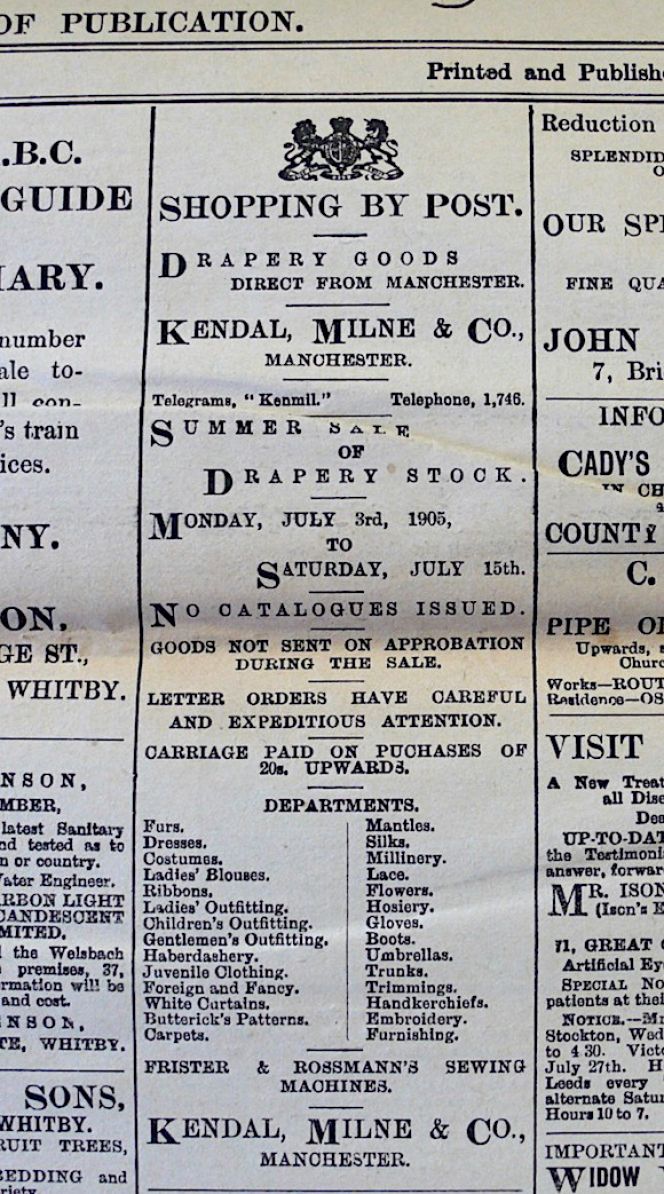 During the first decade of the 20th century “shopping by post” became an increasingly familiar concept, with cheap freight and rapid delivery its selling points – which advertisers in the Whitby Gazette frequently mentioned. Like this advertisement on 30 June, 1905, ‘Kendal, Milne & Co. Manchester’. (Collection: Whitby Museum, Library & Archive). Photo: Viveka Hansen, The IK Foundation, London.
During the first decade of the 20th century “shopping by post” became an increasingly familiar concept, with cheap freight and rapid delivery its selling points – which advertisers in the Whitby Gazette frequently mentioned. Like this advertisement on 30 June, 1905, ‘Kendal, Milne & Co. Manchester’. (Collection: Whitby Museum, Library & Archive). Photo: Viveka Hansen, The IK Foundation, London.One firm interested to develop its postal sales was Kendal, Milne & Co, a Manchester department store with roots dating back to the 1830s that advertised regularly in the Whitby Gazette, see an advertisement from 1905 above comprehensively describing their stock. Another example of catalogue selling can be seen with Oxendale & Co. of Northallerton, who, in August 1910, held a sale of clothes and fabrics and urged ‘Write today for Catalogue of Bargains, 52 pages, post free.’ Or customers could be tempted with a single product mass-produced so that it could be sold at an attractively low price. 1909 saw three examples of this technique in the Whitby Gazette, including Hudsons of Leeds, who sold skirts in Herringbone Cheviot – a strong tweed cloth – in various colours ‘Post Free’. They described their illustrated advertisement in the following terms:
- ‘Buy Direct, By purchasing your Skirts from us you get the best possible value at the most economical prices. Send a Postal Order value 5s. 11d., together with your waist measurement and the length required to Hudson’s, 1 & 3 Burmantofts’, Leeds, and you will receive, by return of post, a Tailor-made Skirt just like the one illustrated here. If it does not give you the Fullest satisfaction we will refund your money in full.’
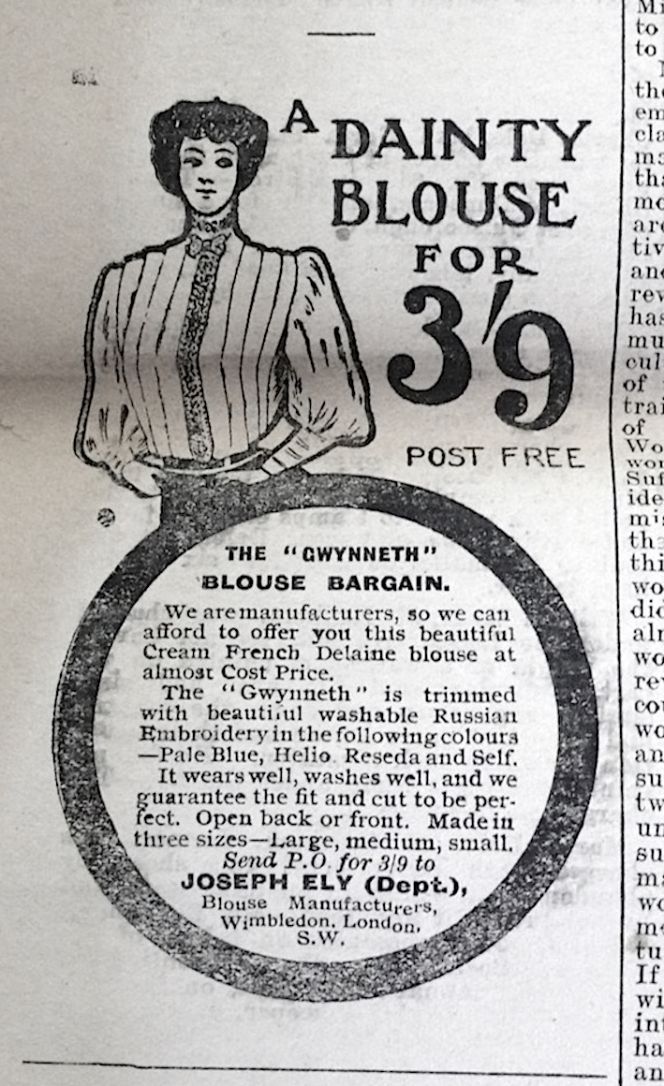 ‘Joseph Ely (Dept.), Blouse manufacturer, Wimbledon, London’ – a department store founded in 1876 – advertised ‘A Dainty Blouse for 3/9 Post Free’. Their advertisement in Whitby Gazette April 1909 showed in both text and illustration how fashionably up-to-date the blouse was, its reasonable price and attractive form, the chance to choose between various shades of colour, the embroidery, was washable and available in various sizes. (Collection: Whitby Museum, Library & Archive). Photo: Viveka Hansen, The IK Foundation, London.
‘Joseph Ely (Dept.), Blouse manufacturer, Wimbledon, London’ – a department store founded in 1876 – advertised ‘A Dainty Blouse for 3/9 Post Free’. Their advertisement in Whitby Gazette April 1909 showed in both text and illustration how fashionably up-to-date the blouse was, its reasonable price and attractive form, the chance to choose between various shades of colour, the embroidery, was washable and available in various sizes. (Collection: Whitby Museum, Library & Archive). Photo: Viveka Hansen, The IK Foundation, London.On 20 January 1905, a ‘Great Clearance Sale’ was advertised at ‘Dickson & Benson, Ltd., The Arcade & Linthorpe Road, Middlesbro’, with a detailed description of a wide variety of clothes, accessories and domestic linen. Readers from Whitby were offered a special incentive:
- ‘The whole advantages and opportunities offered at this Sale are available to residents in Whitby as though they were close neighbours in Middlesbrough. For ever purchase over £1 Single Railway fare is allowed. For over £2 Full Return Fare. Moreover, your letters get every attention. Carriage is paid on all parcels. Patterns sent of everything with Pleasure.’
If they did a big shop at Dickson & Benson, they would have no extra expense either for their journey or for the transportation of what they had bought, on top of having the benefit of access to such a huge choice of products for sale.
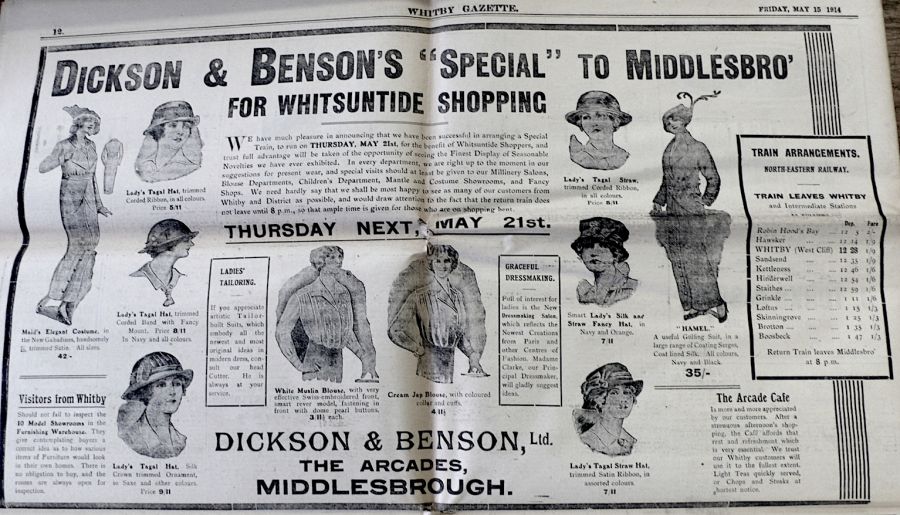 During 1905-1914 Middlesbrough department stores tempted the people of Whitby with large illustrated advertisements describing a more extensive stock than it was possible to find in their home town. The advantages of planning a proper day’s excursion for shopping were frequently emphasised, since the coastal train now made each town easily accessible to the other. Advertisement in Whitby Gazette, May 15 in 1914, ‘Dickson & Bensons, Middlesbro’. (Collection: Whitby Museum, Library & Archive). Photo: Viveka Hansen, The IK Foundation, London.
During 1905-1914 Middlesbrough department stores tempted the people of Whitby with large illustrated advertisements describing a more extensive stock than it was possible to find in their home town. The advantages of planning a proper day’s excursion for shopping were frequently emphasised, since the coastal train now made each town easily accessible to the other. Advertisement in Whitby Gazette, May 15 in 1914, ‘Dickson & Bensons, Middlesbro’. (Collection: Whitby Museum, Library & Archive). Photo: Viveka Hansen, The IK Foundation, London.New advertisements of this nature must have hit the smaller shops of Whitby hard, considering both the much larger assortment of products they made available to local people at competitive prices, in addition to the attractive novelty of being able to shop away from home. In the spring of 1914 too, this same firm published large illustrated advertisements showing fashions ‘For Whitsuntide Shopping’. This particular advertisement also contained a railway timetable, which suggested leaving Whitby by train at 12.28 to reach Middlesbrough at about 2, and ‘Return Train leaves Middlesbro’ at 8 p.m.’, giving customers plenty of time for shopping.
Another department store that had increased the size of its advertisement to take up a whole page in the spring of 1909 was ‘Middlesbrough’s Great Shopping Centre. Excelsior’. Here, too, women’s fashions dominated both the illustrations and the accompanying text, and it is clear that this establishment aimed particularly to attract families with modest incomes, without holding back on details of the latest fashions. For example, each garment was marked with a very attractive price and the hat department contained ‘Copies of Expensive Models’. There was also a third department store in this field promoting both women’s and men’s clothes and home furnishing textiles during 1911-1912 in large advertisements. In January 1911, one might be tempted by: ‘M. Robinson & Son’s The Coliseum, Stockton On Tees. Great Winter Sale... See N.E.R. Advt. For Excursions from Whitby & West Cliff...’ Though most people still used the train for longer journeys, cars were now increasingly available to the better-off, and during the next decade – which lies outside this study – they would make moving about easier still. This in turn further encouraged shopping away from one’s home base, permitting a new independence and mobility that no longer needed to depend on such public transport as coaches, steamships and trains.
Sources:
- Adburgham, Alison, Shops and Shopping 1800-1914, London 1967.
- Hansen, Viveka, The Textile History of Whitby 1700-1914 – A lively coastal town between the North Sea and North York Moors, London & Whitby 2015. (pp. 120-125 & 406-407).
- Whitby Gazette, 1860-1914 (Whitby Museum, Library & Archive).
- Whitby Museum, Library & Archive (Whitby Lit. & Phil.).
Essays
The iTEXTILIS is a division of The IK Workshop Society - a global and unique forum for all those interested in Natural & Cultural History from a Textile Perspective.
Open Access essays - under a Creative Commons license and free for everyone to read - by Textile historian Viveka Hansen aiming to combine her current research and printed monographs with previous projects dating back to the late 1980s. Some essays also include unique archive material originally published in other languages, made available for the first time in English, opening up historical studies previously little known outside the north European countries. Together with other branches of her work; considering textile trade, material culture, cloth manufacturing, fashion, natural dyeing and the fascinating world of early travelling naturalists – like the "Linnaean network" – from a Global history perspective.
For regular updates, and to make full use of iTEXTILIS' possibilities, we recommend fellowship by subscribing to our monthly newsletter iMESSENGER.
been copied to your clipboard




– a truly European organisation since 1988
Legal issues | Forget me | and much more...
It is free to use the information/knowledge in The IK Workshop Society so long as you follow a few rules.
 LEARN MORE
LEARN MORE








